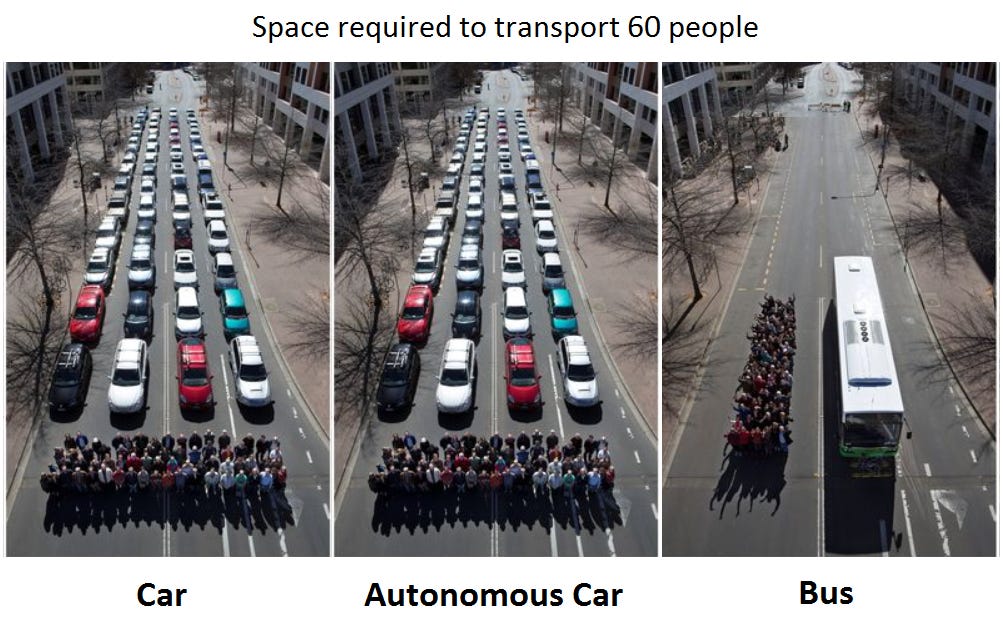Issue 11
Towards a more conscious autonomous future: Part Three
This is the third part of a piece on cities and autonomous vehicles. Find Part One here and Part Two here.
The Upshot
We cannot rely on the adoption of autonomous vehicles to solve urban transport woes. Even if they are able to steer clear of the human-exacerbated causes of congestion, the induced demand effect as well as the additional traffic caused by empty cars shuttling between pick-up and drop off (exactly such a phenomenon has already occurred in cities thanks to Uber and Lyft) mean that AVs will not be the be-all-end all fix to congestion, and may even make it worse.
It would be a mistake for local and national governments to think that encouraging the growth and use of AVs, whether through infrastructure planning or regulation, is going to fix problems they face. It may be advantageous to do so for other reasons—the economic benefits of ensuring that the U.S. leads the inevitable transition to AVs will no doubt be vital, for example—but that’s a topic for another day.
It is possible to encourage this kind of economic development, however, without allowing AVs to overrun cities the way that the first generation of driver-controlled automobiles have.
Former NYC traffic commissioner Sam Schwartz:
We know now that our last century’s approach to cars led to the hollowing out of cities, the destruction of transit systems, and a vicious cycle of urban populations decreasing and becoming poorer, of city services being cut and crime becoming rampant. From 1899 to 2013, 3,613,732 people died in motor vehicle accidents in the United States, with another 80 million people injured, many of them permanently maimed.4 I don’t think this level of lethality was the outcome Americans were hoping for when they first embraced the car. That was not the promise people were offered….
The current lack of laws governing AVs represents an opportunity to get new laws right and revise existing laws wisely, to set policy that works for everyone and doesn’t favor just carmakers. If a state wants to make AV manufacturing guidelines more rigorous than the minimum set by national laws, that should be allowed. Let’s not overrule states with a quest for uniform national laws that favor car manufacturers and ease safety standards on AVs. If a community doesn’t feel that it’s ready for level 5 AVs, it should be able to legislate to that end. We should not stand in the way of a state that wants to prohibit AVs in cities with more than one million people until logistics and networking and other issues like pedestrian safety are sorted out.
In every area of regulation, lawmakers have to ensure that people are privileged over cars, and that in the rush to innovate, unsafe or untested vehicles are not allowed to come on the market. What’s the rush if safe cars can be advanced ahead of self-driving cars? We cannot let manufacturers take the lead in creating laws that benefit only them, as they did in the last century, when the first car manufacturers made sure that new laws governing driving pushed pedestrians to the sidelines. We do not want to repeat the mistakes of the past.
–No One at the Wheel, Samuel Schwartz
Already, there are indications that automakers are doing the opposite—privileging cars over people. A new expose in the New York Times today suggests that Elon Musk may have pushed self driving over safety in its development of Tesla Autopilot.
AVs will not solve our problems. But, as unsexy as it is, we know what will: mass transit and improved bike and pedestrian infrastructure. Even the most die-hard technologists should be open to the idea.
Good public infrastructure offers a better quality of life to all involved and offers a salve to the urban housing affordability crisis—a problem that keeps VCs like Cyan Banister and Peter Thiel up at night. (See our profile of Cyan here.)
A Harvard study even showed that commuting time was the single strongest factor in a person’s odds of escaping poverty.
The math behind mass transit is clear.
This is a freeform daily newsletter about the transportation industry: Planes, Trains, and Automobiles. I take shallow dives into topics that I think are interesting, including write ups of startups in the space, historical explorations, market analyses, company and personal profiles, interviews with industry players, and occasional personal essays.
Thanks for reading—and please let me know if you have any feedback or if there is anything you would like to see me cover.
Ride well,
DS

